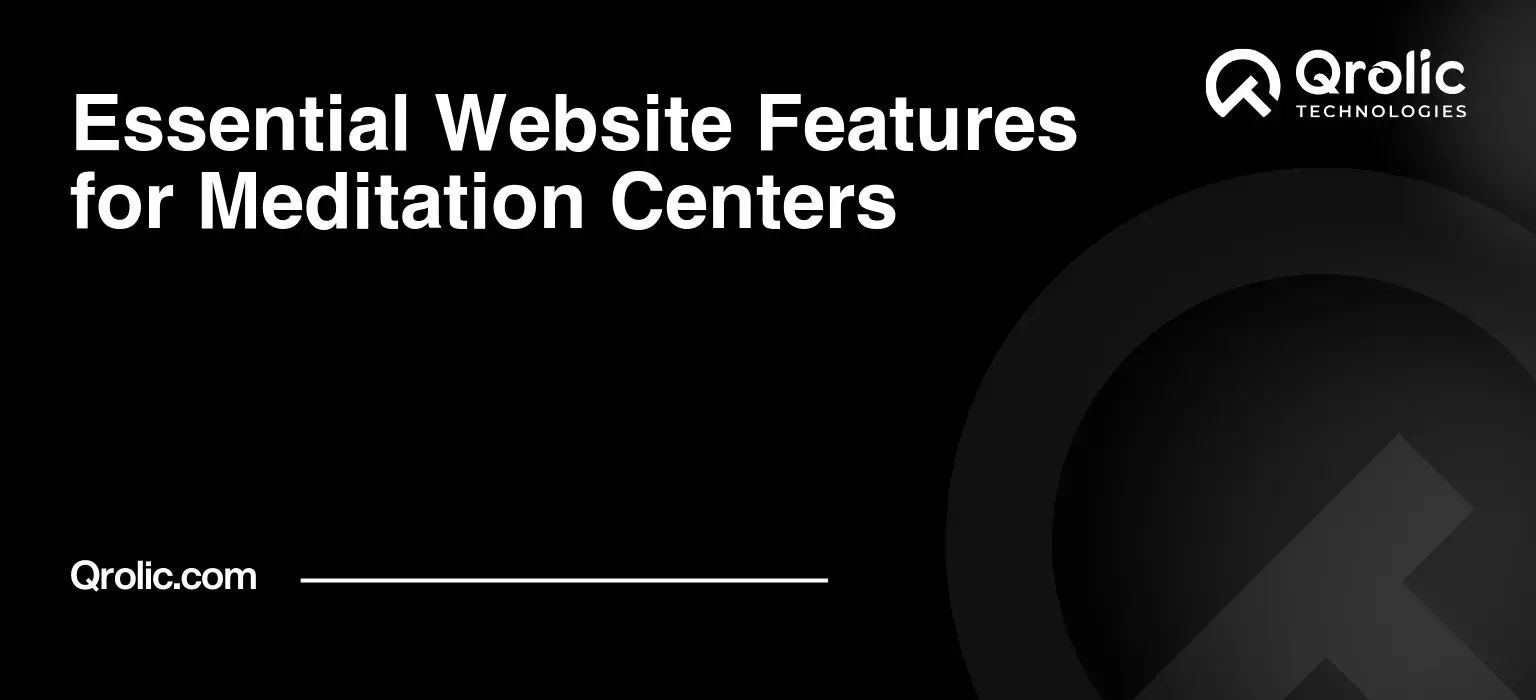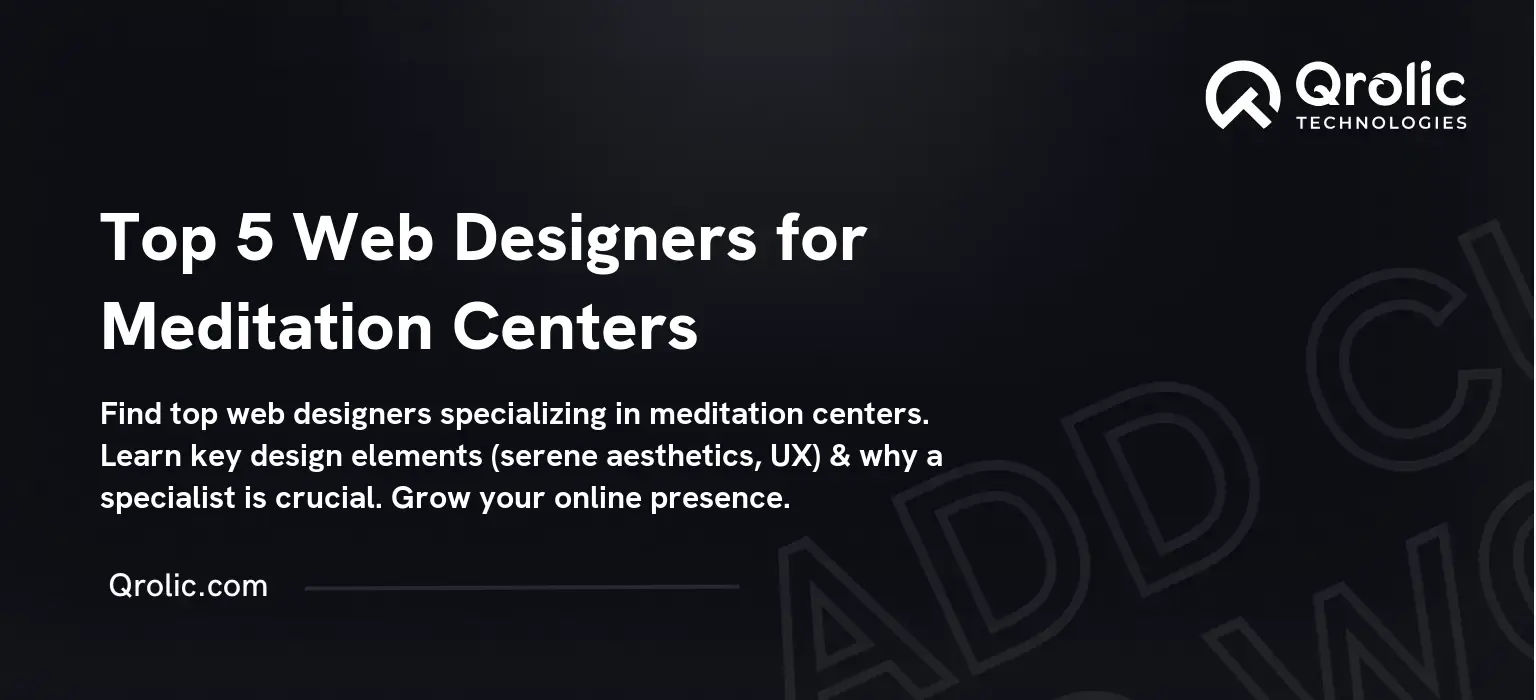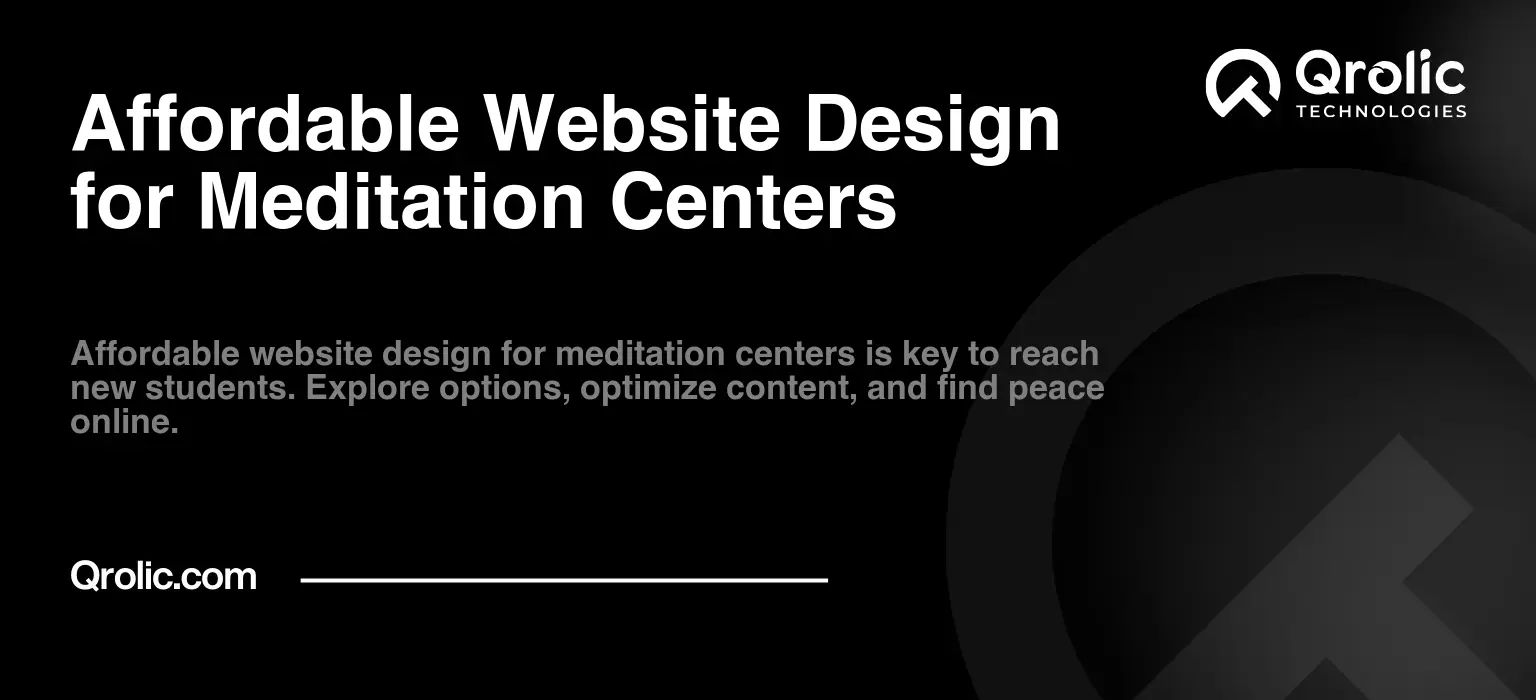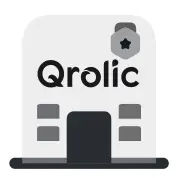Quick Summary:
- A strong website is vital for attracting new students.
- Include core pages like classes, teachers, and contact info.
- Add features like event calendars, blogs, and registration forms.
- Ensure your site is fast, secure, and mobile-friendly.
Table of Contents
- Why a Powerful Website is Vital for Your Meditation Center
- Core Foundation: Essential Pages for Every Meditation Center Website
- 1. Homepage: Your Digital Welcome Mat
- 2. About Us: Building Trust and Connection
- 3. Meditation Practices: Guiding Visitors to the Right Path
- 4. Class Schedule: Making it Easy to Participate
- 5. Contact Us: Facilitating Communication
- Essential Features for Enhanced User Experience and Engagement
- 6. Event Calendar: Showcasing Workshops, Retreats, and Special Events
- 7. Registration Form: Streamlining the Enrollment Process
- 8. Blog: Sharing Wisdom and Building Authority
- 9. Online Store: Selling Merchandise and Supporting Your Center
- 10. Member Portal: Creating a Community Hub
- 11. Testimonials and Reviews: Building Trust and Credibility
- 12. Multi-Language Support: Reaching a Wider Audience
- 13. Search Functionality: Helping Visitors Find What They Need
- 14. Social Media Integration: Expanding Your Reach
- 15. Accessibility: Ensuring Inclusivity for All
- Behind the Scenes: Technical Essentials
- 16. Fast Loading Speed: Keeping Visitors Engaged
- 17. Mobile Responsiveness: Reaching Users on Any Device
- 18. SEO Optimization: Attracting Organic Traffic
- 19. Security: Protecting Your Data and Visitors
- 20. Analytics Tracking: Measuring Your Success
- Qrolic Technologies: Your Partner in Creating a Thriving Digital Presence
- Final Thoughts: Creating a Digital Sanctuary
Why a Powerful Website is Vital for Your Meditation Center
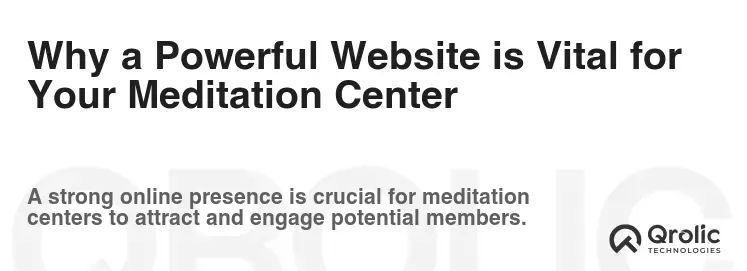
In today’s interconnected world, your website is often the first interaction potential students have with your meditation center. It’s your digital storefront, your online sanctuary, and a crucial tool for attracting new members, nurturing existing relationships, and fostering a thriving community. A well-designed website, equipped with the right features, can significantly enhance your center’s reach, impact, and overall success. Think of it as your digital ambassador, representing the peace, clarity, and well-being you offer to the world. It’s not just about having a presence online; it’s about creating an experience that resonates with visitors and inspires them to take the next step on their meditation journey.
Core Foundation: Essential Pages for Every Meditation Center Website
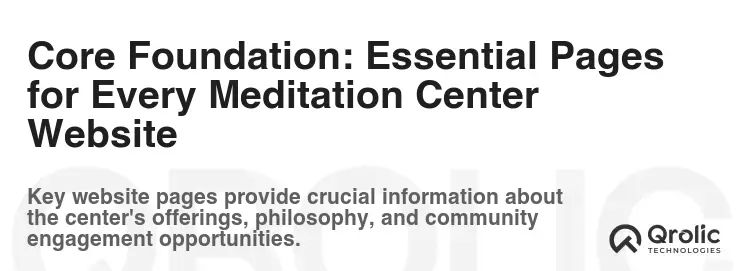
1. Homepage: Your Digital Welcome Mat
The homepage is your most valuable piece of digital real estate. It needs to immediately capture the visitor’s attention, communicate your center’s essence, and guide them towards the information they seek.
-
Impactful Visuals: High-quality images or videos showcasing your center’s ambiance, teachers, or community events. Avoid stock photos that feel generic. Authentic visuals resonate far more deeply.
-
Compelling Headline: A clear and concise headline that immediately conveys the benefits of meditation and the unique value proposition of your center. Examples: “Find Inner Peace at [Center Name]”, “Cultivating Mindfulness in [City Name]”, “Your Journey to Serenity Starts Here.”
-
Brief Introduction: A short, heartfelt paragraph summarizing your center’s mission, values, and the type of meditation practices you offer. Focus on the feeling you want to evoke, not just the facts.
-
Clear Calls to Action (CTAs): Prominent buttons that encourage visitors to take the next step: “Explore Our Classes,” “Register for a Free Session,” “Meet Our Teachers,” “Learn More About Meditation.” Use action-oriented language.
-
Testimonials: Short, powerful testimonials from satisfied students. Social proof is incredibly effective in building trust.
-
Upcoming Events Snippet: Showcase a few upcoming events to pique interest and encourage registration.
-
Mobile Responsiveness: Absolutely critical. Ensure your homepage looks and functions flawlessly on all devices.
2. About Us: Building Trust and Connection
This page is your opportunity to connect with visitors on a personal level and establish trust. Share your story, your values, and the passion behind your center.
-
Your Center’s Story: Share the origin story of your center – why it was founded, what inspired it, and what impact it aims to make.
-
Mission and Values: Clearly articulate your center’s mission and the core values that guide your work. This helps visitors understand what you stand for.
-
Teacher Profiles: Detailed profiles of your meditation teachers, including their backgrounds, qualifications, experience, and personal stories. Include photos and videos to build a personal connection.
-
Emphasis on Authenticity: Be genuine and authentic in your tone. Avoid corporate jargon and speak from the heart.
-
Pictures of the Center: Showcase the physical space of your meditation center. People want to know where they’ll be practicing. Include pictures of the meditation hall, common areas, and outdoor spaces (if applicable).
3. Meditation Practices: Guiding Visitors to the Right Path
This page should clearly explain the different types of meditation practices you offer, catering to beginners and experienced practitioners alike.
-
Detailed Descriptions: Provide clear and concise descriptions of each meditation practice, including its origins, techniques, benefits, and suitability for different individuals.
-
Target Audience: Identify which practices are best suited for beginners, intermediate practitioners, or those with specific needs (e.g., stress reduction, anxiety management).
-
Multimedia Content: Include guided meditation audio samples or short video tutorials to give visitors a taste of the practice.
-
Benefits Highlighted: Clearly outline the benefits of each meditation practice, such as reduced stress, improved focus, increased self-awareness, and enhanced well-being.
-
Examples: Mindfulness Meditation, Vipassana Meditation, Transcendental Meditation, Yoga Nidra, Walking Meditation, Loving-Kindness Meditation.
4. Class Schedule: Making it Easy to Participate
An easily accessible and clearly presented class schedule is essential for attracting and retaining students.
-
User-Friendly Interface: Use a clean and intuitive layout that allows visitors to quickly find the classes they’re interested in.
-
Filtering and Sorting: Implement filtering options to allow users to filter classes by type, day of the week, time of day, teacher, and location (if you have multiple locations).
-
Mobile Optimization: Ensure the class schedule is easily viewable and navigable on mobile devices.
-
Direct Registration Links: Include direct links to the registration page for each class.
-
Calendar Integration: Allow users to add classes to their personal calendars (Google Calendar, iCal, etc.).
5. Contact Us: Facilitating Communication
A clear and accessible contact page makes it easy for potential students to reach out with questions and inquiries.
-
Contact Form: A simple and user-friendly contact form with fields for name, email address, phone number (optional), and message.
-
Email Address and Phone Number: Display your email address and phone number prominently.
-
Physical Address and Map: Include your physical address and a Google Maps integration to help visitors find your center.
-
Social Media Links: Link to your social media profiles.
-
Response Time: State your typical response time to inquiries (e.g., “We typically respond within 24 hours”).
Essential Features for Enhanced User Experience and Engagement
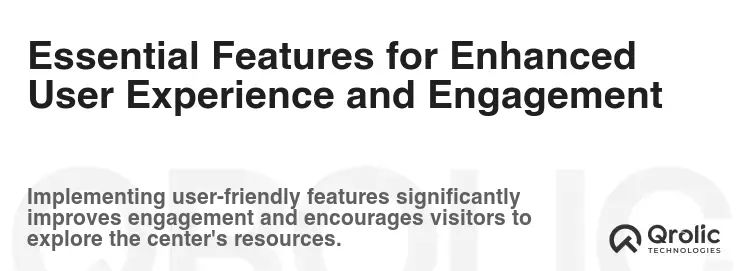
6. Event Calendar: Showcasing Workshops, Retreats, and Special Events
A well-designed event calendar is crucial for promoting workshops, retreats, special events, and other offerings that go beyond regular classes.
- Visually Appealing Design: Use a clean and modern calendar design that is easy to navigate and visually appealing.
- Detailed Event Information: Each event listing should include a detailed description, date, time, location, pricing, teacher, and registration link.
- Filtering and Search: Implement filtering options to allow users to filter events by type, date range, teacher, and location. A search function is also helpful.
- Categorization: Events should be properly categorized (e.g., workshops, retreats, guest speaker events).
- Recurring Events: Easily manage recurring events, such as weekly meditation groups or monthly workshops.
- Integration with Registration System: Seamless integration with your registration form ensures a smooth registration process.
- Prominent Display: The event calendar should be easily accessible from the homepage and navigation menu.
- SEO Optimization: Optimize event listings with relevant keywords to improve search engine visibility.
- Keywords Example: “Mindfulness Retreat [City Name]”, “Meditation Workshop for Beginners [City Name]”, “Weekend Yoga Retreat [Region Name]”.
- Shareable Events: Enable users to easily share events on social media platforms.
7. Registration Form: Streamlining the Enrollment Process
A user-friendly registration form is essential for capturing leads and enrolling students in classes, workshops, and retreats.
- Simple and Intuitive Design: The registration form should be easy to understand and navigate, even for users who are not tech-savvy.
- Essential Fields Only: Only ask for the information you absolutely need. Too many fields can deter users from completing the form.
- Clear Instructions: Provide clear instructions for each field.
- Mobile Responsiveness: The registration form must be fully responsive and functional on all devices.
- Payment Integration: Integrate with secure payment gateways (e.g., Stripe, PayPal) to allow users to pay online.
- Automated Confirmation Emails: Send automated confirmation emails to users upon successful registration, including details about the class or event.
- Data Security: Ensure the security of user data by using SSL encryption and complying with privacy regulations.
- Conditional Logic: Implement conditional logic to show or hide fields based on user input.
- Integration with CRM: Integrate the registration form with your CRM (Customer Relationship Management) system to manage leads and customer data.
- Accessibility: Ensure the registration form is accessible to users with disabilities, following WCAG guidelines.
- Spam Protection: Implement spam protection measures, such as CAPTCHA, to prevent fraudulent registrations.
8. Blog: Sharing Wisdom and Building Authority
A blog is a powerful tool for sharing valuable content, building your center’s authority, and attracting organic traffic to your website.
- Informative and Engaging Content: Publish articles, guides, and personal stories related to meditation, mindfulness, and well-being.
- SEO Optimization: Optimize blog posts with relevant keywords to improve search engine rankings.
- Keywords Example: “Benefits of Meditation for Anxiety”, “How to Start a Daily Meditation Practice”, “Mindfulness Techniques for Stress Reduction”.
- Variety of Topics: Cover a wide range of topics that are relevant to your target audience.
- Consistent Posting Schedule: Establish a consistent posting schedule to keep your audience engaged.
- Guest Blogging: Consider inviting guest bloggers to contribute to your blog.
- Visual Content: Include images, videos, and infographics to enhance the visual appeal of your blog posts.
- Call to Action: Include a call to action at the end of each blog post, encouraging readers to sign up for your newsletter, register for a class, or contact you for more information.
- Comments Section: Enable comments to encourage discussion and engagement.
- Social Sharing Buttons: Make it easy for readers to share your blog posts on social media.
9. Online Store: Selling Merchandise and Supporting Your Center
An online store can be a valuable source of revenue and a way to extend your center’s brand beyond the physical space.
- Meditation Cushions and Mats: Offer a variety of meditation cushions and mats in different sizes, shapes, and materials.
- Books and CDs: Sell books and CDs on meditation, mindfulness, and related topics.
- Incense and Essential Oils: Offer a selection of incense and essential oils that are commonly used in meditation practices.
- Clothing and Accessories: Sell branded clothing and accessories, such as t-shirts, hoodies, and tote bags.
- Gift Cards: Offer gift cards that can be redeemed for classes, workshops, or merchandise.
- Secure Payment Processing: Integrate with secure payment gateways to ensure the safety of customer transactions.
- Easy Navigation: Make it easy for customers to browse and find the products they are looking for.
- High-Quality Product Images: Use high-quality product images to showcase your merchandise.
- Detailed Product Descriptions: Provide detailed product descriptions that include information about the materials, dimensions, and benefits of each item.
- Customer Reviews: Encourage customers to leave reviews to build trust and credibility.
10. Member Portal: Creating a Community Hub
A member portal can provide exclusive content, resources, and community features for your students.
- Exclusive Content: Offer exclusive content, such as guided meditations, articles, and videos, that are only available to members.
- Community Forum: Create a community forum where members can connect with each other, share their experiences, and ask questions.
- Discounts and Perks: Offer discounts on classes, workshops, and merchandise to members.
- Personalized Profiles: Allow members to create personalized profiles and track their progress.
- Event Calendar: Include an event calendar that highlights upcoming events and activities.
- Resource Library: Create a resource library with articles, videos, and other materials related to meditation and mindfulness.
- Secure Access: Ensure that the member portal is secure and accessible only to registered members.
- Easy Navigation: Make it easy for members to find the information and resources they are looking for.
- Mobile Accessibility: Ensure that the member portal is accessible on mobile devices.
11. Testimonials and Reviews: Building Trust and Credibility
- Prominent Placement: Display testimonials prominently on your homepage, about us page, and other relevant pages.
- Authenticity: Use real testimonials from real students.
- Variety: Include a variety of testimonials that highlight different aspects of your center.
- Visuals: Include photos of the students who provided the testimonials.
- Third-Party Reviews: Link to your profiles on third-party review sites, such as Google Reviews and Yelp.
- Encourage Reviews: Encourage your students to leave reviews on these sites.
- Respond to Reviews: Respond to both positive and negative reviews in a professional and timely manner.
12. Multi-Language Support: Reaching a Wider Audience
If your center is located in a multilingual community, consider adding multi-language support to your website.
- Professional Translation: Use professional translators to ensure the accuracy of your website content.
- Language Selector: Provide a language selector that allows users to choose their preferred language.
- SEO Optimization: Optimize your website for different languages.
- Cultural Sensitivity: Be mindful of cultural differences when translating your website content.
13. Search Functionality: Helping Visitors Find What They Need
- Prominent Placement: Place the search bar in a prominent location, such as the header or sidebar.
- Relevance: Ensure that the search results are relevant to the user’s query.
- Suggestions: Provide search suggestions as the user types.
- Filtering: Allow users to filter search results by category, date, and other criteria.
14. Social Media Integration: Expanding Your Reach
- Social Sharing Buttons: Add social sharing buttons to your blog posts, events, and other content.
- Social Media Feeds: Embed your social media feeds on your website.
- Social Media Login: Allow users to log in to your website using their social media accounts.
15. Accessibility: Ensuring Inclusivity for All
- WCAG Compliance: Ensure that your website complies with the Web Content Accessibility Guidelines (WCAG).
- Alternative Text: Provide alternative text for all images.
- Keyboard Navigation: Ensure that your website can be navigated using a keyboard.
- Color Contrast: Use sufficient color contrast to make your website easy to read.
- Font Size: Allow users to adjust the font size.
Behind the Scenes: Technical Essentials

16. Fast Loading Speed: Keeping Visitors Engaged
Website speed is crucial for user experience and SEO. slow-loading websites lead to higher bounce rates and lower search engine rankings.
- Optimize Images: Compress images without sacrificing quality.
- Use a Content Delivery Network (CDN): Distribute your website content across multiple servers to improve loading speed for users around the world.
- Minimize HTTP Requests: Reduce the number of HTTP requests by combining files and using CSS sprites.
- Enable Browser Caching: Allow browsers to cache static assets to reduce loading time for returning visitors.
- Choose a Fast Hosting Provider: Select a hosting provider that offers fast and reliable performance.
17. Mobile Responsiveness: Reaching Users on Any Device
A mobile-responsive website adapts to different screen sizes and devices, providing a seamless user experience on smartphones, tablets, and desktops.
- Responsive Design: Use a responsive design framework to ensure that your website looks and functions flawlessly on all devices.
- Mobile-Friendly Navigation: Simplify your navigation menu for mobile devices.
- Touch-Friendly Elements: Use touch-friendly buttons and links.
- Test on Different Devices: Test your website on different devices and screen sizes to ensure that it is fully responsive.
18. SEO Optimization: Attracting Organic Traffic
Search Engine Optimization (SEO) is the process of optimizing your website to rank higher in search engine results pages (SERPs).
- Keyword Research: Conduct keyword research to identify the keywords that your target audience is using to search for meditation centers.
- On-Page Optimization: Optimize your website content with relevant keywords, meta descriptions, and title tags.
- Off-Page Optimization: Build backlinks from other reputable websites.
- Content Marketing: Create high-quality content that is valuable to your target audience.
- Technical SEO: Optimize your website’s technical aspects, such as site speed, mobile responsiveness, and site architecture.
19. Security: Protecting Your Data and Visitors
Website security is essential for protecting your data and your visitors’ data from cyber threats.
- SSL Certificate: Install an SSL certificate to encrypt data transmitted between your website and your visitors’ browsers.
- Strong Passwords: Use strong passwords for all of your website accounts.
- Regular Backups: Back up your website regularly to protect against data loss.
- Security Plugins: Install security plugins to protect your website from malware and other security threats.
- Keep Software Up-to-Date: Keep your website software, including your CMS, plugins, and themes, up-to-date to patch security vulnerabilities.
20. Analytics Tracking: Measuring Your Success
Analytics tracking allows you to monitor your website’s performance and identify areas for improvement.
- Google Analytics: Install Google Analytics to track website traffic, user behavior, and conversions.
- Conversion Tracking: Set up conversion tracking to measure the effectiveness of your marketing campaigns.
- Regular Reporting: Generate regular reports to analyze your website’s performance and identify trends.
- Data-Driven Decisions: Use data to make informed decisions about your website design, content, and marketing strategy.
Qrolic Technologies: Your Partner in Creating a Thriving Digital Presence
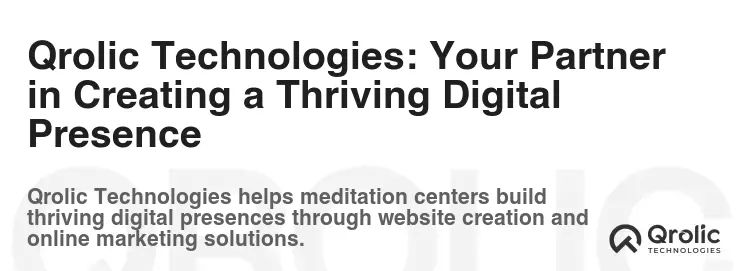
Qrolic Technologies (https://qrolic.com/) is a leading provider of web design and development services, specializing in creating custom websites for businesses and organizations of all sizes. We understand the unique needs of meditation centers and can help you create a website that is both beautiful and functional, attracting new students and fostering a thriving online community.
How Qrolic Technologies Can Help Your Meditation Center:
- Custom Website Design: We create custom website designs that reflect your center’s brand and values.
- Mobile-Responsive Development: We ensure that your website is fully responsive and functional on all devices.
- SEO Optimization: We optimize your website for search engines to help you attract organic traffic.
- E-commerce Integration: We can integrate an online store into your website to sell merchandise and support your center.
- Membership Management: We can develop a member portal that provides exclusive content, resources, and community features for your students.
- Ongoing Support: We provide ongoing support and maintenance to ensure that your website is always up-to-date and secure.
Why Choose Qrolic Technologies:
- Experience: We have years of experience creating websites for businesses and organizations in various industries.
- Expertise: Our team of skilled web designers and developers is passionate about creating beautiful and functional websites.
- Customer Focus: We are committed to providing excellent customer service and ensuring that you are completely satisfied with our work.
- Affordable Pricing: We offer competitive pricing to fit your budget.
Contact Qrolic Technologies today to learn more about how we can help you create a thriving digital presence for your meditation center.
Final Thoughts: Creating a Digital Sanctuary
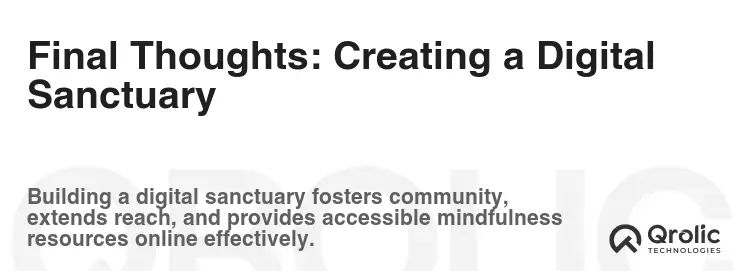
Your website is more than just a marketing tool; it’s a digital sanctuary where visitors can learn about your center, connect with your community, and embark on their meditation journey. By incorporating these essential features, you can create a website that not only attracts new students but also fosters a sense of peace, well-being, and connection. Remember to prioritize user experience, provide valuable content, and continuously optimize your website to meet the evolving needs of your audience. With a well-designed and thoughtfully executed website, your meditation center can thrive in the digital age and make a positive impact on the world.
